Julia Olennikova How to Uncover Your Competitors’ Ad Strategies with SEMrush Display Advertising … Wow-Score collecting now The Wow-Score shows how engaging a blog post is. It is calculated based on the correlation between users’ active reading time, their scrolling speed and the article’s length. Learn more How to Uncover Your Competitors’ Ad Strategies with SEMrush Display Advertising
- 5
- 3
- 7
Display advertising is suffering from two controversial yet die-hard myths. There are those who think display campaigns are all about spraying and praying, and there are those who think “it has too many settings, I will never have enough time to dig into it”.
However, with display advertising growing in popularity year over year, we can see that marketers do get profits from this channel.
One of the ways to steer clear of the budget drain in display campaigns is competitive analysis. Whether you are just planning your first campaign or want to improve your active campaigns, you can find precious insights that will add some extra value to your advertising strategy.
Let’s take a look at four aspects to be considered when evaluating competitors’ GDN (Google Display Network) campaigns. We will use the website bicyclewarehouse.com as an example and SEMrush’s Display Advertising report as the main data source.
Ad Formats
In GDN, there are several types of ads: text, image, rich media, etc. By analyzing which format is used more often by your competitors, you can get an idea of the most successful ad types in your niche.
In SEMrush, the ads found on publisher websites are divided into three categories:
– Media – ads containing only images (either static or dynamic)
– HTML – responsive ads containing both images and text blocks
– Text – responsive ads containing only text
We used the Advertising Competitors and Ads History reports to find potential GDN competitors of bicyclewarehouse.com. Let’s take a look at one of them, bikesdirect.com, and see the proportion of ads this domain has ever placed in GDN (since 2013):
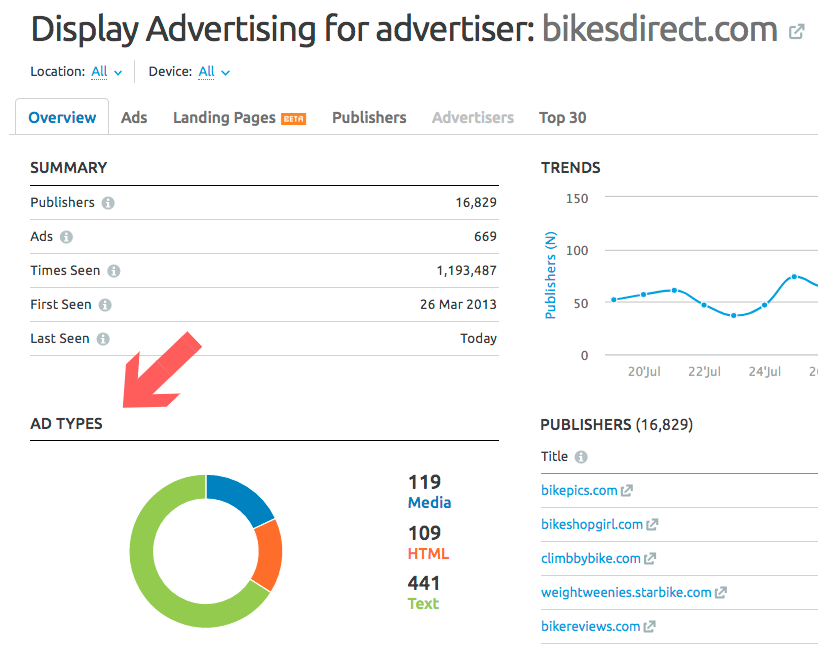
And, to see the current ads breakdown, we’ll go to the ‘Ads’ tab and get an overview of how the situation has been changing over the last 30 days:

We figured out that during the last month this advertiser didn’t run HTML ads at all. It could mean that this format didn’t work well for them, and this is a reason to stop and see if the same is happening to other websites in your niche.
Also, it is a signal that this domain has some well-performing media ads which are worth exploring (and we will get to this later).
If you are running campaigns in different countries, the 'Location' filter will provide you with more information to reflect upon. For instance, we found some interesting trends concerning ad formats in the US and the UK:
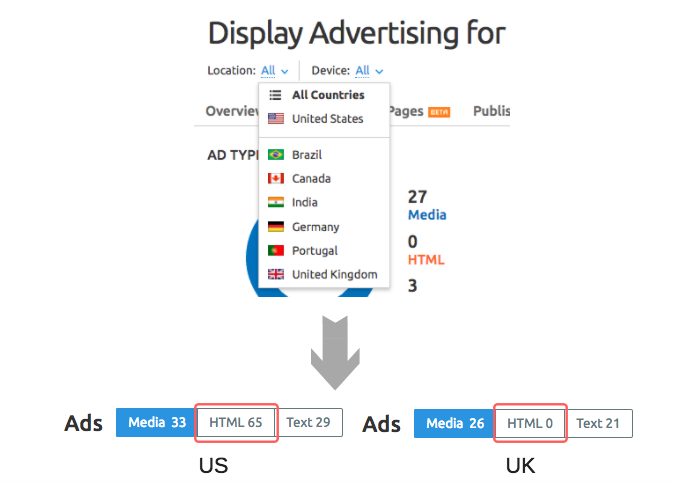
We see that this advertiser has never used HTML ads for the UK, while in the US this is the most popular format. So you might want to dig deeper to see if this is typical for other websites. And if it is, you have two options: stop offering responsive HTML ads to your British customers or, on the contrary, try experimenting with this format in your campaigns for the UK.
Devices
With mobile slowly but surely overtaking desktop, a thorough analysis of devices which are being targeted in your niche is a must.
To find out which OS and devices your competitors prefer to focus on, use the ‘Device’ filter in the ‘Ads’ tab:
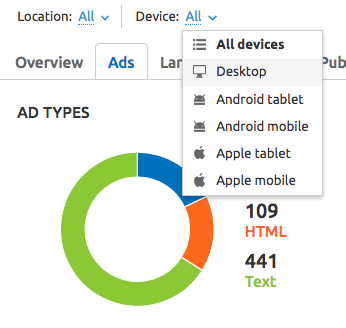
Here are a couple of insights you can find exploring the competitors of the analyzed domain:
1. Bikesdirect.com tended to place its HTML ads much more on mobile and tablet devices rather than desktop:
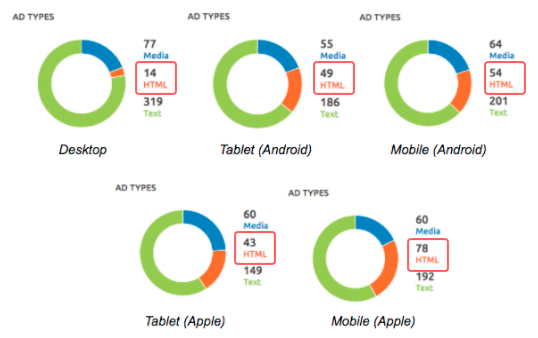
2. Modernbike.com was generally focusing more on mobile (both Android and Apple):

3. The same trend can be seen for yoeleobike.com:

This doesn’t mean that targeting only mobile and tablet users (strictly with HTML ads) will be your silver bullet. But it looks like the hypothesis deserves a test.
Publishers
Choosing the right targeting option is crucial.

GDN's 'thing' is that it's automated to a great extent. But this can turn against you (see the picture above). However, you can minimize risks and increase the chances for your ads to appear on relevant websites.
In Display Advertising report, you can see which websites your competitors are putting their ads on by switching to the ‘Publishers’ tab:

So, what should you pay attention to when exploring this report? First of all, note the publishers that have been showing the domain’s ads most often. They are worth exploring because they are probably driving relevant traffic to your competitor’s website.

Out of these websites, climbbybike.com, definitely deserves attention:
– It has been one of the three most active publishers since 2013 even though it started running the advertiser’s ads only in 2016.
– It has active ads right now.
– The website has a thriving community of cycling fans.
Click on the number of ads in the first column to explore the ad creatives that were noticed on this publisher’s website:
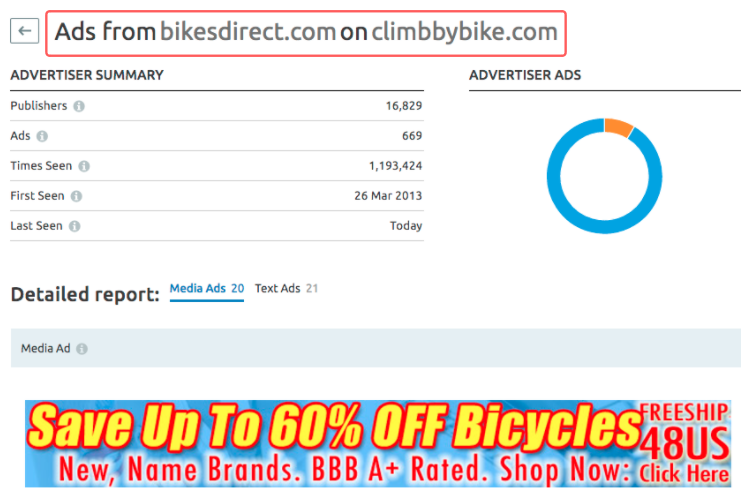
You can extract more useful data from the ‘Publishers’ report. Try sorting the list by the ‘First seen’ criterion to find interesting newly added publishers. The table below will explain in more detail which publishers place which type of ad formats (we noticed that for 9 out of top 10 publishers of bikesdirect.com text ads were the most used ad type):
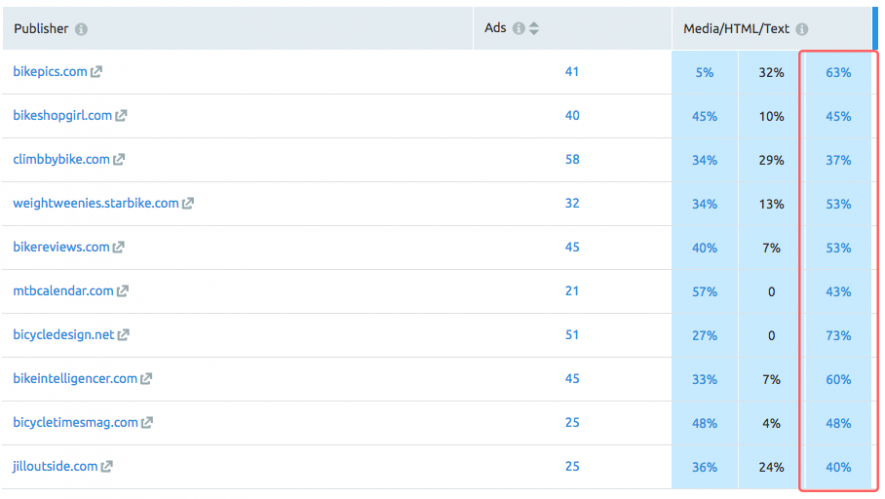
After you repeat these steps for several competitors and come up with a list of relevant publishers, add them as ‘managed placements’ in AdWords.
Live Ad Examples
Now that you have an idea on the best formats to choose, devices to target and publishers to whitelist, there is a little left to do: create ads.
Growing your golden pool of CTAs, visuals and unique selling propositions take time. It also requires brainstorming sessions, noticeable investments in split tests and hours of analysis.
If you don't want to go down the long route, consider exploring which of your competitors' ads are already bringing them traffic. Go to the ‘Ads’ tab and sort the ad list by 'Times seen' to get the (potentially) most effective ones at the top:
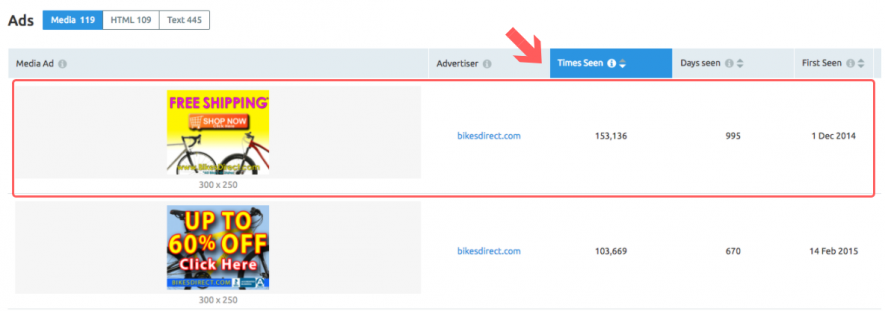
For bikesdirect.com, we see that the record holding media ad has been active since December 2014. Clicking on the ad will bring you to the detailed report: you’ll also be able to see the landing page and the list of publishers for this banner.
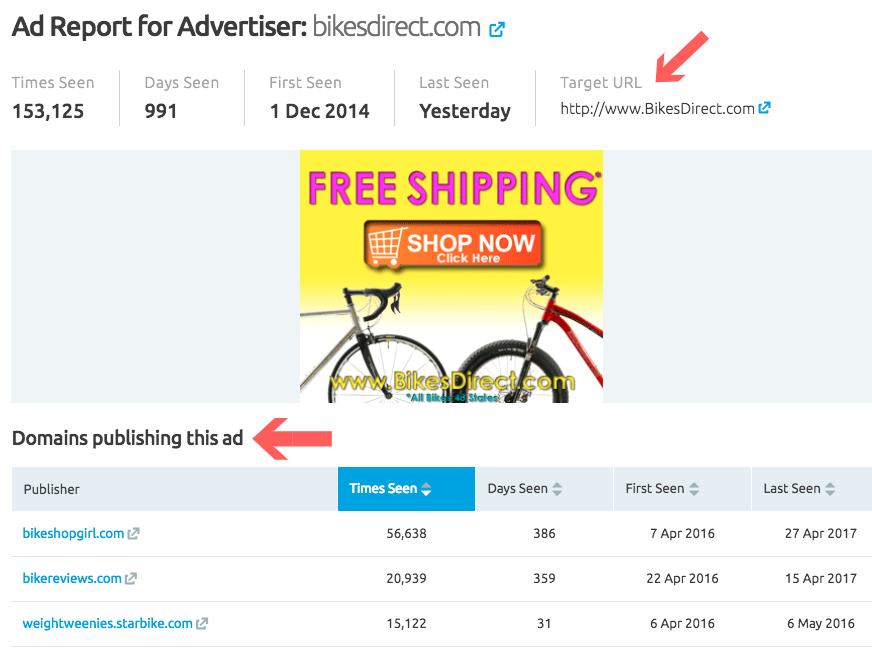
Switch to the ‘HTML’ tab to borrow some ideas for “mixed” ads and then to the ‘Text’ tab to discover the most used calls to action and USPs:
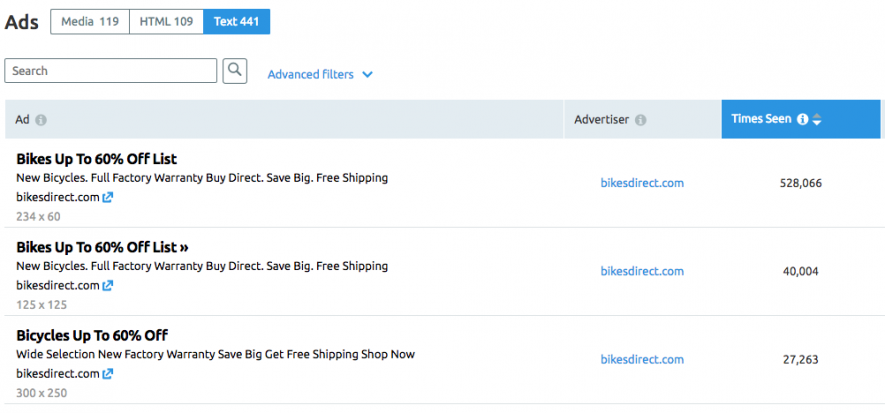
We have analyzed the most popular media ads of five more competitors and came up with some ideas on what messages seem to work best for bike retailers. 728×90 turned out to be the most frequently used ad size, and the focus on prices and discounts is obvious:

Passing the mic over to you!
The principles your competitors use for their display advertising are not the ultimate truth you are destined to follow. But a closer look at your competitors’ ad strategies will definitely help you clear things up in terms of how to tweak or not to tweak your campaigns.
We'd love to hear about your experience with display campaigns and, in particular, about competitive analysis stage. Have you used others' best practices? Did they work for you? Is it common practice for you to analyze your competitors' campaigns before launching your own one? Share your thoughts in the comments!
Breathe life into your PPC
With Display Advertising tool
Please specify a valid domain, e.g., www.example.com Try now! Discover SEMrushRead the original article here



